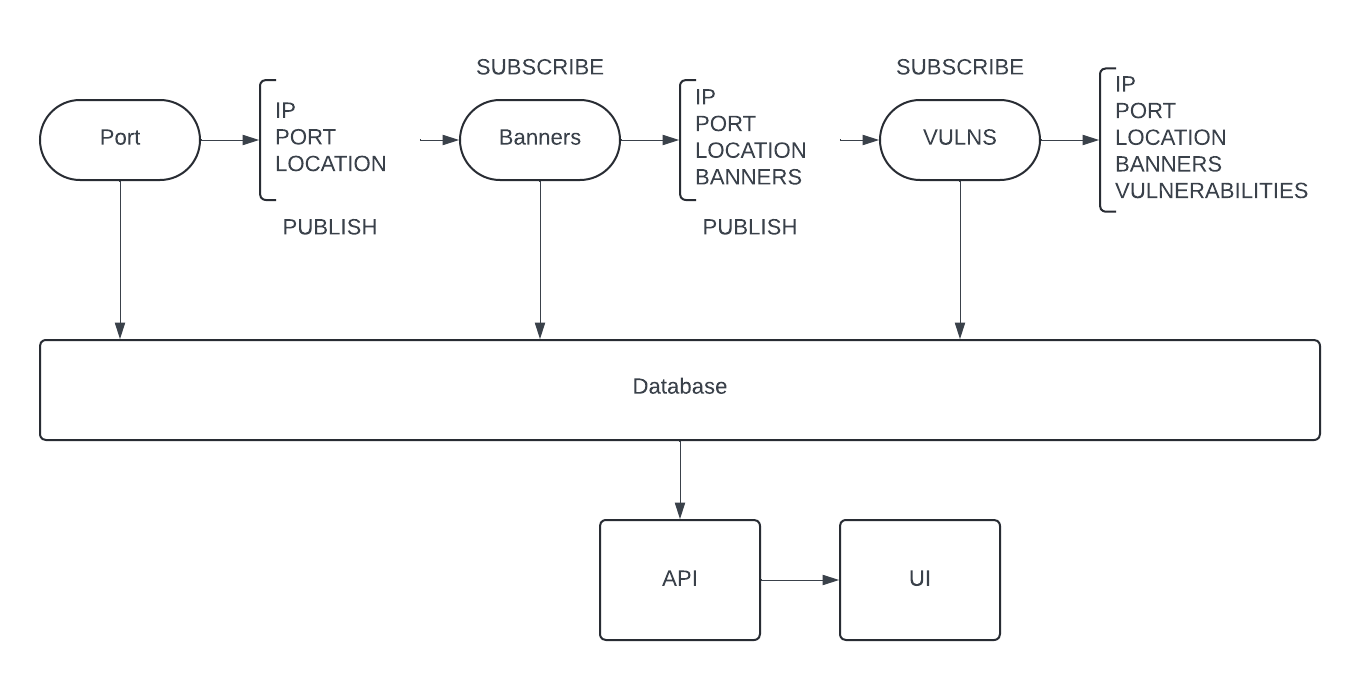Rigour is a comprehensive Internet of Things (IoT) scanning tool designed to discover, analyze, and report on devices connected to the internet. By leveraging powerful tools like ZMap and ZGrab, Rigour performs large-scale network scans to identify active hosts, retrieve service banners, and detect potential vulnerabilities. It offers both REST and streaming APIs for data access, and includes a user interface for data visualization.
To quickly set up Rigour and its services, use Docker Compose:
docker compose upThis command initializes all components required for scanning, data processing, and data access.
Rigour's architecture comprises several interconnected components that work in harmony to perform comprehensive network scanning and analysis.
The Port Scanner uses ZMap to scan specified port ranges and identify active hosts on the internet. Discovered hosts are published to a RabbitMQ queue in the format {country}.{port}.{ip}.port. This allows other services to consume live data for further processing. Additionally, scan results are stored in the database for persistent access.
The Banner Grabber employs ZGrab to retrieve service banners from the identified hosts, providing detailed information about running services (e.g., SSH, HTTP). This service subscribes to the {country}.{port}.{ip}.port queue and publishes the collected banners to {country}.{port}.{ip}.banners. The database entries for each host are updated with this new information.
The Vulnerability Scanner analyzes the collected banner data to detect vulnerable servers by cross-referencing with CVE databases. It examines identifiers such as HTTP server headers against known vulnerabilities. This service subscribes to the {country}.{port}.{ip}.banners queue and publishes its findings to {country}.{port}.{ip}.vulns. Host documents in the database are updated with vulnerability details.
Rigour provides a RESTful API to access the scanned host data programmatically. The API allows for querying hosts, services, and vulnerabilities.
- Documentation: Detailed API documentation is available here.
For real-time data processing, Rigour offers a streaming API via RabbitMQ queues.
The RabbitMQ queues follow this naming convention:
{country}.{port}.{ip}.{data_type}{country}: Two-letter country code (e.g.,USfor the United States){port}: Port number being scanned (e.g.,443){ip}: IP address of the host (e.g.,192.168.1.1){data_type}: Type of data (port,banners, orvulns)
US.443.192.168.1.1.portThis structure facilitates easy identification and routing of data based on geographic location, port, host, and data type.
A web-based User Interface is available for visualizing scan results and interacting with the data.
Note: The user interface is in early development stages and requires manual startup.
- Network Capacity: High scanning rates set in ZMap may consume significant network bandwidth, potentially causing other services to experience latency or connectivity issues.
- Process Resilience: Current processes do not automatically resume after a crash. If a service like the Banner Grabber fails, it will not pick up where it left off upon restarting. Enhancements to address this limitation are planned for future releases.
- ISP/Organization Mapping: Incorporate mapping of IP addresses to Internet Service Providers or organizations to provide more context.
- DNS Mapping: Implement DNS resolution to associate hostnames with IP addresses.
- Campaign Configurability: Introduce configurable scanning campaigns, allowing users to specify ports, protocols, and data types to capture.
